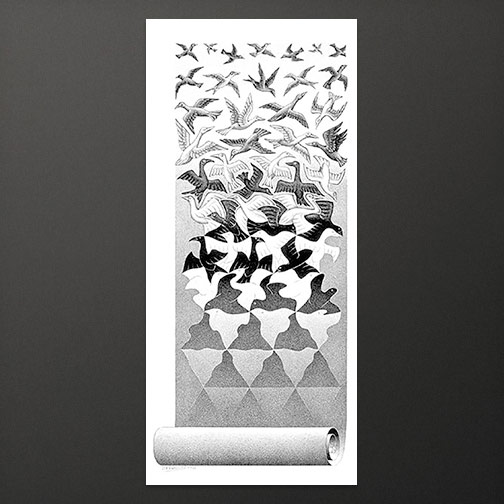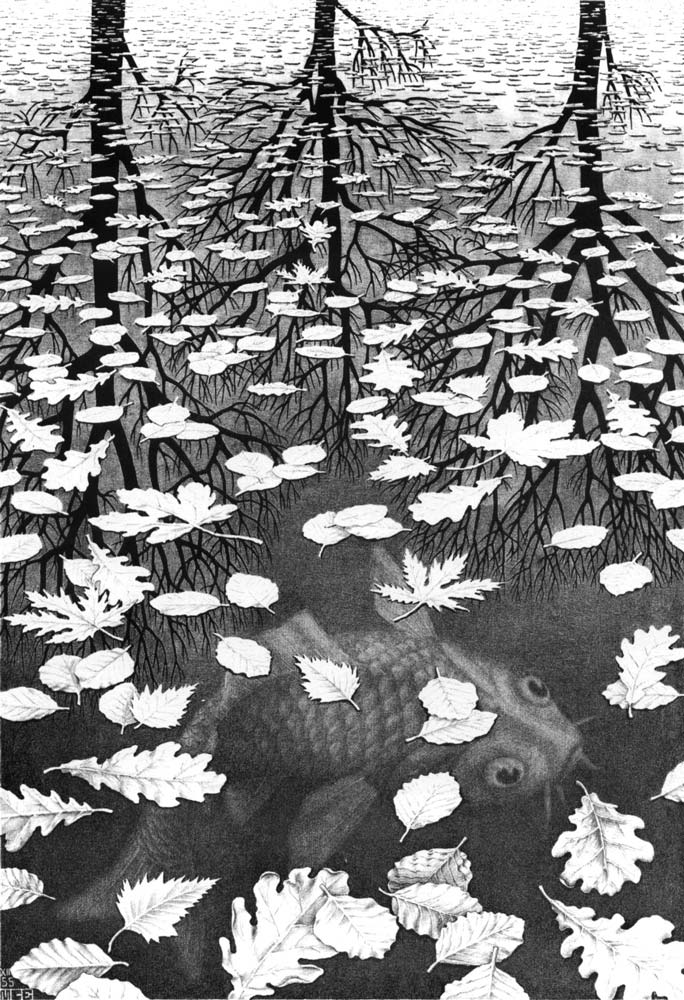Maurits Cornelis Escher was born on June 17, 1898, in Leeuwarden, Netherlands. The interest in art has been present in a boy’s life from an early age, but he did not have a lot of success. A couple of failed attempts later, Maurits got into the School of Architecture and Decorative Arts. There he studies architecture but later switches to graphic arts. After finishing school, he goes to Italy and meets his future wife, Jetta Umiker. The couple spends their life in Italy (11 years), Switzerland, and Belgium (6 years), and then return to the Netherlands, where they live for 31 years.
Escher’s World and way of life have influenced his art tremendously. His love for mathematical and geometrical models and philosophical interpretation of objects was at the core of his works. Escher was fascinated with Italy, and while living in this country, he created many works depicting the coasts, villas, and nature of this poetic land. The mosaics of the country’s old castles inspire Maurits’ future style frames.
Gravity and the order
Escher was the author of many inspirational and interesting quotes. Finding correlations between his art and expressions may help understand the artist’s thinking pattern. The first quote of his: “We adore chaos because we love to produce order,” is a perfect opportunity to analyze his works’ philosophy. People enjoy disarray because it creates a possibility of applying order, which is a constant human desire. Escher is a master of order, and he demonstrates it with one of his best works, Gravity.
This piece of art is a metaphor for people’s desire to create order. At the center of the lithography is a star-like object, which provides a habitat for creatures. This may sound like complete chaos, but Escher manages to bring order to the situation. The object in the middle is perfectly shaped and consists of multidimensional, pyramid-looking structures situated on every plain. The creatures have an odd skin color, and their body types are similar to a lizard, but the author captures every beast in the pyramid. The symbiosis of the fantastical creatures and cosmic objects created in order, so reminiscent of a human’s mind, is the display of people’s craves for structure and logic.
The second Maurits’ phrase is: “To have peace with this peculiar life; to accept what we do not understand; to wait calmly for what awaits us, you have to be wiser than I am.” The piece of art relatable to this quote is Relativity. This is a perfect example of the artist not applying his philosophical templates in life, but doing so in his works. The lithograph is one of Escher’s “impossible” works because it displays different plains and dimensions. The representation of the viewpoint makes this work unique on every observation, but the most crucial part of this lithograph is its message.
People exist at the same time, and everybody has a unique point of view. Every person in the lithograph lives in a different dimension. The stairs may go up for one character and go down for the other, representing the differences in life and the simultaneous existence. The message correlates with a quote because even though life is different for each person, the correct way to live is by calmly waiting for the future to unfold.
Analysis of Liberation through a structural frame

Liberation is one of the most inspiring tessellation works of M.C. Escher. This piece of art is a lithograph, so often a technique of choice for Maurits. Elements of this work represent themes of freedom, courage, and resistance. Escher created a very dynamic image, where the progress pushes the observer’s look upwards. The lines of the triangles in the lower part are becoming increasingly misshaped. The usage of space and tone creates a focal point on the difference between freedom and captivity. In the lower part of the work, the triangles are dark, the space between them is gloomy, and the shapes are under the water surface. They represent the unattractiveness of such life and the distance between people and their nature.
Near the middle of the art piece, triangles acquire a bird-like shape but still contain the same dark pallet. The spacing between the birds is tight, which demonstrates the hardship of becoming free. In the upper part of the work, birds acquire different shapes, tones and have more space between them, symbolizing freedom. The lithograph genre is the Optical Illusion Art, defined by the manifestation of the objects and the natural elements’ appliance in the surreal world (the triangles misshaped as being underwater).
Escher plays with the viewer’s perspective with the placing of elements in the lithograph. The triangles under the water are meant to represent people looking down, or rather bowing their heads. On the other hand, birds in the sky are keeping the viewer’s head up, providing hope and divine quality of freedom. The period of Liberation’s creation is widely accepted to be one of the most productive in Escher’s career. Because of World War II, the artist and his family moved back to the Netherlands. After the years spent in Italy, Escher was not happy with the homeland’s lack of visual inspiration and weather conditions, so the only way to deal with the discontent was to work. This may also be the reasoning behind the Liberation’s motive because just as birds desired freedom, the artist was hoping to go back to Italy.
Analysis of Three Worlds through the subjective frame

Three Worlds is one of Escher’s best works, done is the woodcut technique. An observer sees what is supposed to be a lake in the fall. This image invokes a feeling of an uninviting nature, loneliness, and despair, which viewers may feel through the main objects. With its expressive eyes, the fish seems to be alone in the whole lake, which creates an atmosphere of loneliness. Fall brings cold weather, while the leafless trees contribute to the composition’s pessimistic mood.
Once the first impression is gone, the technological efficiency of the work comes to a realization. Escher has once again displayed his ability to create multi-dimensional pieces by putting three different stories in one time span. The observer sees the fish underwater, the leaves on the surface, and the trees that supposedly stand on the shore. Not only does it create an impressive piece of art, but it also represents the three stages of life. The first stage is that of living time, depicted by the fish underwater. The second stage is a loss, which can also mean aging, metaphorically displayed by the leaves which fell from the trees. And the final stage is death, or rather disappearance, presented by the lonely, leafless trees.
The author wants people to gradually witness this work of art, leading from simple observation to the realization of its complex structure. The artist plays with the observer’s attention, placing three main objects (trees, leaves, fish) in one plain sight. The technique of combining reflections and water lens that surround the viewer’s point of view is an incredible display of mastership. This work is similar to Escher’s Puddle because it provides two perspectives in one woodcut job.